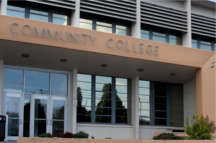
Former president Obama has hailed community colleges as providing a “gateway to millions of Americans to good jobs and a better life.” But somewhere along the way, community college students have lost sight of the dream. A report by NSC Research Center 2018 shows that around 39 percent of the students who began at a two-year community college completed a degree within 6 years, whereas 46.2 percent of the students were no longer enrolled by the end of their study period.
If succeeding at community college seems more and more like a long shot, you can take control of your experience. Find out how to avoid the main traps that keep community college students from graduating.
Identifying opportunities at community colleges
Community colleges provide a crucial link to career opportunity for many students. Unlike many four-year universities, the tuition remains affordable. Course scheduling is flexible, with online, partially online and accelerated programs that let students learn on demand and at their own pace. Broad support services help students connect the dots between high school and a skilled job or a bachelor’s degree.
Accessibility does not come without challenges, however. According to a report by the National Center of Education Statistics (NCES), in fall 2017, 34 percent of undergraduate students attended community colleges (17 percent of full-time undergraduates and 58 percent of part-time undergraduates). As you can see, few fit the traditional mold of the full-time, 18-year-old campus resident who relies on Mom and Dad to foot the bill. More than half attend part-time and commute to campus. Many are adults returning to school; the average age in a community college classroom is 29.
“Community colleges attract students because of the flexible nature of the curriculum. For part-time students, schoolwork is a competing priority among many,” said Dr. Elizabeth Bugaighis, dean of education and academic success at Northampton Community College.
With many students balancing work alongside family and work obligations, it’s no wonder so many lose their focus along the way.
Key obstacles to college completion
Community college administrators, counselors and state public policy analysts identify these major obstacles to degree completion:
- Remedial education. Research by the Center for American Progress says that anywhere between 40 to 60 percent of first-year community college students arrive in the classroom only to find themselves sidetracked down an extended road of remedial classes that don’t count toward the degree. Bachelor’s degree-seeking students who take a remedial course in the first year after high school graduation are 74 percent more likely to drop out of college than those who do not take remedial education, according to Education Reform Now. Remedial classes in mathematics, writing and reading cost students time, money and self-confidence. Even among those that do graduate, bachelor’s program students take 11 months longer and associate program students take 6 months longer to complete the entire program along with remedial education, than those who do not take remedial studies.
- Part-time attendance. Students who attend college part-time risk tipping the balance between school and other life priorities. Northampton Community College Professor of Counseling Dr. Virginia Gonzalez works with students individually to determine whether a part-time schedule is right for them. “To succeed with a part-time schedule, students need a great deal of determination and discipline,” she said.
However, community colleges nationwide are taking steps to remove the obstacles students face on the road to a degree.
How to beat the odds at community college
Here are four common traps community college students fall into, as well as escape routes you can use to stay on the path to success at community college.
Problem #1: Remedial classes slow down my progress toward a degree or certificate.
Solution: Community colleges are transforming remedial education to help prevent students exiting or falling out of the programs by:
- using multiple measures to assess postsecondary readiness and accordingly place students in developmental courses
- compressing or mainstreaming developmental education with course redesign, such as offering co-requisite college-level courses
- implementing comprehensive, integrated, and long-lasting support programs
California community colleges, for instance, are ensuring that the students complete college-level English and mathematics within a one-year time frame.
Problem #2: Academic requirements don’t seem relevant to my life or career ambitions.
Solution: Colleges are taking steps to align course curricula more closely with employer demand and real-world practice. Carnegie Foundation focused on engaging students in the statistical and quantitative reasoning concepts as they are more relevant to many students’ educational and career goals than those in the traditional algebraic sequence. The two programs, Statway and Quantway, focus on math education you can use, with applied instruction in statistics, data analysis and quantitative reasoning. According to Carnegie 2016-17 Impact Report, Statway and Quantway have achieved steady enrollment growth at 64%, since their launch in 2011. In 2016-2017, total enrollment was 7,522 — nearly five times that of the first year of enrollment — with 415 sections taught by 224 faculty members across 48 institutions.
Problem #3: Studying is #3 on my list of priorities, after kids and my day job.
Solution: Seek out people who can help you prioritize. Helping you achieve a work-life-school balance is the job of the community college academic advisor.
“Part of making it through college requires a careful balance of life and school,” says former counselor Celinda Smith of Bellevue College, current academic advisor of University of Washington, Bothell.
Dr. Gonzalez of Northampton stresses the importance of having an upfront conversation with a counselor about how to balance your priorities before embarking on a degree program.
Problem #4: I don’t know what it takes to succeed in my classes.
Solution: Community colleges are going the extra mile to help students develop effective learning strategies. SUNY Ulster offers time management and study skills workshops. At Northampton Community College, Dr. Gonzalez developed a 3-credit college success course targeting three skill areas: study skills, informational literacy and critical thinking. The course has raised retention rates, and students report increased confidence and success in other classes. Other schools may offer a trial period where you can test your comfort with online degrees or get a flavor for a class.
Problem #5: I have difficulty in learning material on my own and in keeping up with schedules in online programs
Solution: Community colleges have been focusing on improving course design and extending meaningful support services to improve online education. In fact, a 2017 report by California Community Colleges show the number of students choosing online programs have been steadily increasing over the last 10 years. The gap in success rates between traditional face-to-face (71 percent) and online education program (66 percent) has closed from 17 percent in 2006 to 4 percent in 2016-17. The California Community Colleges Online Education Initiative provides online instructional support to help alleviate the concerns students have about taking classes online.
With these tips in mind, dedication and resourcefulness can take you from enrollment to graduation.
“Successful students achieve a balance and take advantage of the resources and services available to them,” says Wendy McCorry, Assistant Dean for Student Success at SUNY Ulster.
Sources
- Education Reform Now Embargoed, April 2016, https://www.insidehighered.com/sites/default/server_files/files/EdReformNow%20O-O-P%20Embargoed%20Final.pdf
- Obama hails community colleges, skirts their lack of funds, McClatchy Newspapers, October 2010, https://www.mcclatchydc.com/news/politics-government/article24595966/
- Developmental Education Challenges and Strategies for Reform, January 2017, https://www2.ed.gov/about/offices/list/opepd/education-strategies.pdf
- Remedial Education Reforms at California Community Colleges, August 2018, https://www.ppic.org/wp-content/uploads/remedial-education-reforms-at-californias-community-colleges-august-2018.pdf
- Carnegie Foundation 2016-2017 Impact Report, January 2018, https://storage.googleapis.com/cmp-wordpress-public-uploads/1/pathways_descriptive_report_january_2018.pdf
- Distance Education Report 2017, accessed May 2019, https://californiacommunitycolleges.cccco.edu/Portals/0/Reports/2017-DE-Report-Final-ADA.pdf
- Online and Homegrown, Inside Higher Ed, October 2016, https://www.insidehighered.com/news/2016/10/13/californias-online-education-initiative-connects-community-college-classes-across
- Enrollment and Employees in Postsecondary Institutions, Fall 2017; and Financial Statistics and Academic Libraries, Fiscal Year 2017: First Look, January 2019, https://nces.ed.gov/pubsearch/pubsinfo.asp?pubid=2019021rev
- Completing College National 2018 – Figure 15, December 2018, https://nscresearchcenter.org/signaturereport16/
- Remedial Education, Center for American Progress, September 2016, https://www.americanprogress.org/issues/education-k-12/reports/2016/09/28/144000/remedial-education/
- Distance Education Report 2017, California Community Colleges, accessed May 2019, http://californiacommunitycolleges.cccco.edu/Portals/0/Reports/2017-DE-Report-Final-ADA.pdf

